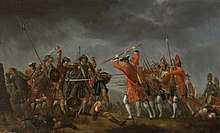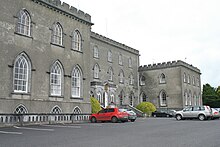Charles Moore, 1st Marquess of Drogheda
The Marquess of Drogheda | |
|---|---|
 Charles Moore, 1st Marquess of Drogheda | |
| Chief Secretary for Ireland | |
| In office 1764–1765 | |
| Preceded by | William Gerard Hamilton |
| Succeeded by | Sir Charles Bunbury |
| Personal details | |
| Born | Charles Moore 29 June 1730 |
| Died | 22 December 1822 (aged 92) Dublin, Ireland |
| Resting place | Drogheda, Ireland |
| Spouse |
Lady Anne Seymour-Conway
(after 1766) |
| Relations | Brabazon Ponsonby, 1st Earl of Bessborough (grandfather) |
| Parent(s) | Edward Moore, 5th Earl of Drogheda Lady Sarah Ponsonby |
| Military service | |
| Allegiance | |
| Branch/service | |
| Years of service | 1744–1797 |
| Rank | Field Marshal |
| Battles/wars | Jacobite risings Campaign against the Whiteboys |
Field Marshal Charles Moore, 1st Marquess of Drogheda KP PC (Ire) (29 June 1730 – 22 December 1822[1]), styled Viscount Moore from 1752 until 28 October 1758 and then as the 6th Earl of Drogheda until 2 July 1791, was an Irish peer and later a British peer, and military officer. He bore the colours of his regiment at the Battle of Culloden in April 1746 during the Jacobite risings and later commanded the 18th Light Dragoons during operations against the Whiteboys in Ireland. He also sat as Member of Parliament in the Irish House of Commons and, having served as Chief Secretary to the Lord Lieutenant of Ireland, he went on to become Master-General of the Irish Ordnance.
Early life
[edit]Moore was the eldest of six sons and two daughters of Edward Moore, 5th Earl of Drogheda and, his first wife, Lady Sarah Ponsonby.[2]
His paternal grandparents were Charles Moore, Lord Moore (a son of Henry Hamilton-Moore, 3rd Earl of Drogheda) and Jane Loftus. His maternal grandparents were the former Sarah Margetson and Brabazon Ponsonby, 1st Earl of Bessborough.[3]
Career
[edit]
Moore joined the Army in 1744 as a cornet in the 12th Dragoons,[4] and bore the colours at the Battle of Culloden in April 1746 during the Jacobite risings.[5] He was promoted captain in 1750 and reached the rank of major in 1752 and the rank of brevet lieutenant-colonel on 18 January 1755.[4] Promoted to brevet colonel of dragoons on 19 February 1762,[6] Moore became honorary colonel of his regiment on 3 August 1762.[7] He commanded the 18th Light Dragoons during operations against the Whiteboys in Ireland which started in 1762.[8]
Promoted to major-general on 30 April 1770,[9] Moore became Master-General of the Irish Ordnance and colonel-in-chief of the Royal Irish Artillery in 1770.[5] Moore served as Muster-Master-General in Ireland from May to November 1807 and was promoted to field marshal on 17 July 1821, aged 91.[10]
Political career
[edit]In 1757 Moore became Member of Parliament for St Canice, holding the seat until he succeeded to his father's titles in 1758.[8] He was also elected Grandmaster of the Grand Lodge of Ireland in 1758, a post he held for the next two years.[11] He became Governor of County Meath in January 1759 and lieutenant-colonel commandant of the 19th (later 18th) Light Dragoons on 7 December 1759.[5]
He became Chief Secretary to the Lord Lieutenant of Ireland in 1763, Governor of Kinsale and Charles Fort in 1765[12] and a Lord Justice of Ireland in 1766.[8] He was appointed Custos Rotulorum of King's County in 1766 and Custos Rotulorum of Queen's County in 1769, both offices for life.[5]
He became Member of Parliament for Horsham in 1776,[8] and having been promoted to lieutenant-general on 29 August 1777,[13] he was appointed one of the Founder Knights of the Order of St. Patrick on 17 March 1783.[14]
Peerage
[edit]
Moore succeeded as 6th Earl of Drogheda following the death of his father at sea while travelling from England to Dublin in October 1758.[5]
Created Marquess of Drogheda in the Peerage of Ireland in July 1791[15] in recognition of the support he had given the Government, Moore was promoted to full general on 12 October 1793.[16] He was appointed one of the joint Postmasters General of Ireland in 1797.[17] In January 1801, he was made Baron Moore, of Moore Place in the County of Kent, in the Peerage of the United Kingdom.[18]
Personal life
[edit]On 15 February 1766, Moore married Lady Anne Seymour-Conway, the daughter of Francis Seymour-Conway, 1st Marquess of Hertford. He commissioned Moore Abbey as his country home in 1767.[19] They had eight children, including:[3]
- Charles Moore, 2nd Marquess of Drogheda (1770–1837), an MP for Queen's County from 1790 to 1791 who died unmarried.[3]
- Lady Elizabeth Emily Moore (1771–1841), who married George Nugent, 7th Earl of Westmeath.[3]
- Hon. Henry Moore (d. 1825), who married Hon. Mary Letitia Parnell, second daughter of Henry Parnell, 1st Baron Congleton, and Lady Caroline Elizabeth Dawson (eldest daughter of the 1st Earl of Portarlington), in 1824.[3]
- Lady Mary Moore (d. 1842), who married Alexander Stewart, of Ards, brother of Robert Stewart, 1st Marquess of Londonderry, and second son of Alexander Stewart, in 1791.[3]
- Lady Gertrude Moore, who died unmarried.[20]
- Lady Frances Moore (d. 1833), who married John Ormsby Vandeleur, in 1800.[3]
He was an important patron of the artist William Ashford.[21]
Lord Drogheda died in Dublin on 22 December 1821 and was buried at St Peter's Church in Drogheda.[8][22] His wife's family had a tradition of mental illness, which may explain the fact that their elder son went insane in his twenties.[23]
Descendants
[edit]Through his son Henry, he was a grandfather of the Henry Moore, 3rd and last Marquess of Drogheda.[24]
References
[edit]- ^ The year is sometimes given as 1821. The Annual Biography for 1823 suggests the year was 1822, with his remains arriving in Ireland in January 1823.
- ^ L. G. Pine, The New Extinct Peerage 1884-1971: Containing Extinct, Abeyant, Dormant and Suspended Peerages With Genealogies and Arms (London: Heraldry Today, 1972), page 108.
- ^ a b c d e f g Mosley, Charles, editor. Burke's Peerage, Baronetage & Knightage, 107th edition, 3 volumes. Wilmington, Delaware: Burke's Peerage (Genealogical Books) Ltd, 2003, volume 1, page 1181.
- ^ a b Drummond, Mary M. (1985). Moore, Charles, 6th Earl of Drogheda [I] (1730-1822). Boydell & Brewer. p. 160. ISBN 9780436304200.
{{cite book}}:|work=ignored (help) - ^ a b c d e Dunlop, Robert (2004). "Moore, Charles, first marquess of Drogheda (1730–1822)", rev. Roger T. Stearn". In Stearn, Roger T (ed.). Oxford Dictionary of National Biography (online ed.). Oxford University Press. doi:10.1093/ref:odnb/19099. Retrieved 15 June 2014. (Subscription or UK public library membership required.)
- ^ "No. 10190". The London Gazette. 13 March 1762. p. 1.
- ^ Philippart, John (1820). "The Royal Military Calendar, third edition, volume I (London, 1820)". p. 280. Retrieved 15 June 2014.
- ^ a b c d e Heathcote, p. 222
- ^ "No. 11039". The London Gazette. 5 May 1770. p. 1.
- ^ "No. 2929". The Edinburgh Gazette. 24 July 1821. p. 203.
- ^ Waite, p. 400
- ^ Beatson, Robert (1806). A Politician Index to the Histories of Great Britain and Ireland, volume III. p. 349. Retrieved 15 June 2014.
- ^ "No. 11802". The London Gazette. 2 September 1777. p. 2.
- ^ "No. 12424". The London Gazette. 18 March 1783. p. 2.
- ^ "No. 13322". The London Gazette. 2 July 1791. p. 387.
- ^ "No. 13582". The London Gazette. 15 October 1793. p. 913.
- ^ "Moore, Charles, 6th Earl of Drogheda [I] (1730-1822)". Members Biographies. The History of Parliament Trust. Retrieved 15 June 2014.
- ^ "No. 15327". The London Gazette. 10 January 1801. p. 55.
- ^ "Moore of Moore Abbey - Earls of Drogheda". Turtle Bunbury. Retrieved 15 June 2014.
- ^ Sir Bernard Burke, editor, Burke's Genealogical and Heraldic History of the Peerage, Baronetage and Knightage, 53rd edition (London: Burke's Peerage Ltd, 1891), page 446.
- ^ "A mountainous lake landscape with travellers on a path in the foreground and boats on the lake beyond: Attributed to William Ashford". Christie's. 3 December 2008. Retrieved 15 June 2014.
- ^ The Annual Biography and Obituary. Longman. 1824. p. 427. Retrieved 7 March 2024.
- ^ Hyde, p. 157
- ^ "Moore, Henry Francis Seymour". Dictionary of Irish Biography. Retrieved 7 March 2024.
Sources
[edit]- Heathcote, Tony (1999). The British Field Marshals, 1736–1997: A Biographical Dictionary. Barnsley: Leo Cooper. ISBN 0-85052-696-5.
- Hyde, Montgomery (1959). The Strange Death of Lord Castlereagh. William Heinemann. ASIN B0006D8FGC.
- Waite, Arthur Edward (2007). A New Encyclopedia of Freemasonry. Vol. I. Cosimo Inc. ISBN 978-1-60206-641-0.
External links
[edit]- Postmasters general of Ireland
- 1730 births
- People from County Louth
- Irish soldiers
- British field marshals
- British MPs 1774–1780
- Irish MPs 1727–1760
- Knights of St Patrick
- 19th-century Irish people
- Members of the Parliament of Great Britain for English constituencies
- Members of the Parliament of Ireland (pre-1801) for County Kilkenny constituencies
- Members of the Privy Council of Ireland
- Chief secretaries for Ireland
- Marquesses of Drogheda
- Moore family (Anglo-Irish)
- Peers of the United Kingdom created by George III
- 1822 deaths
- Hereditary peers elected to the House of Commons
